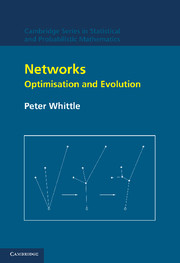Book contents
- Frontmatter
- Contents
- Acknowledgements
- Conventions on notation
- Tour d'Horizon
- Part I Distributional networks
- Part II Artificial neural networks
- Part III Processing networks
- Part IV Communication networks
- Appendix 1 Spatial integrals for the telephone problem
- Appendix 2 Bandit and tax processes
- Appendix 3 Random graphs and polymer models
- References
- Index
Appendix 3 - Random graphs and polymer models
Published online by Cambridge University Press: 23 November 2009
- Frontmatter
- Contents
- Acknowledgements
- Conventions on notation
- Tour d'Horizon
- Part I Distributional networks
- Part II Artificial neural networks
- Part III Processing networks
- Part IV Communication networks
- Appendix 1 Spatial integrals for the telephone problem
- Appendix 2 Bandit and tax processes
- Appendix 3 Random graphs and polymer models
- References
- Index
Summary
The size of this appendix may seem excessive, in view of the limited mention of random graphs in the main body of the text. However, given that a review as meticulous and wide-ranging as that by Albert and Barabási (2002) regards certain central questions as open for which a full analysis exists in the literature, it seems appropriate to give a brief and self-contained account of that analysis. It cannot be long concealed that much of the analysis referred to is that developed by the author over some 30 years. Detailed references are given in the literature survey of Section A3.8; the principal advances are treatment of the so-called first-shell model, leading to the integral representions (A3.13), (A3.31) and (A3.35) of various generating functions, in which a raft of conclusions is implicit.
The random graph model can be expressed either in terms of graphs or in terms of polymers if we identify nodes with atoms, arcs with bonds, components (connected subgraphs) with polymer molecules and node ‘colours’ with types of atom. We shall for preference use the term ‘unit’ rather than atom, since the unit does occasionally have a compound (but fixed) form. The situation in which a ‘giant’ component forms (i.e. in which all but an infinitesimal proportion of the nodes form a single component) is identified with the phenomenon of gelation in the polymer context.
- Type
- Chapter
- Information
- NetworksOptimisation and Evolution, pp. 240 - 260Publisher: Cambridge University PressPrint publication year: 2007

